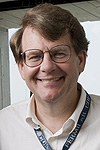Gearing up for summer
 |
|
Mike Lindgren
|
Mike Lindgren, head of the Particle Physics Division, wrote this column.
At a lab like ours, we are driven by particle beams delivered to our world-leading experiments 24 hours a day, seven days a week. The past year—going without beams because of upgrades to the Fermilab accelerator complex—has been unusual. Yet PPD employees have been very busy: We've helped our colleagues of the Accelerator Division with their work in the tunnels, we've worked on the construction of the NOvA and MicroBooNE projects, and we've ramped up the preparations for the LBNE, Mu2e and Muon g-2 projects. I could write thousands of pages on these Intensity Frontier efforts as well as those at the Energy and Cosmic frontiers.
In this column I want to focus on our two newest experiments, NOvA and MicroBooNE, since both have hit important milestones recently.
The MicroBooNE project is a crucial component in our future plans for liquid-argon-based detectors. The project team, from universities and national labs, has been making tremendous progress this past year. Next month we expect to complete the construction of the building that will house the MicroBooNE detector, and the large vessel for the MicroBooNE cryostat, designed to house the experiment's time projection chamber, has just arrived. Our division has nurtured the development of the liquid-argon TPC technology in the United States, and MicroBooNE is an important component in our march to even larger, multi-kiloton detectors. The former DZero assembly building, where we are putting the MicroBooNE detector together before transporting it to the new building, will be humming through the summer.
The NOvA experiment is a technological marvel that will be a vital part for the Intensity Frontier program. Its construction is progressing at a tremendous pace. The crews in Ash River, Minn., have one third of the huge particle detector glued together and in place, and they are filling it with tanker after tanker of scintillating liquid. The first university-built custom electronics and Hamamatsu photodetectors have been installed, and the DAQ crew was able to record cosmic-ray tracks within hours. That's a tremendous achievement on the path to completing what we think will be the largest self-supporting plastic structure ever built.
The underground hall construction for the NOvA near detector on the Fermilab site has been flawless to date, and we expect to take occupancy of the hall soon. PPD technical teams have been busy preparing the east side of the former CDF assembly building to glue together near-detector blocks from modules made at the University of Minnesota factory. There, 250 students have been building the 12,000 modules that make up the experiment while earning money to pay for school.
There is nothing like the thrill of startup, and my colleagues and I can't wait to start running accelerator-based experiments again. And I'm pleased to know that when the beams return this summer, the NOvA experiment will be ready and start reading out several kilotons of particle detector.
|